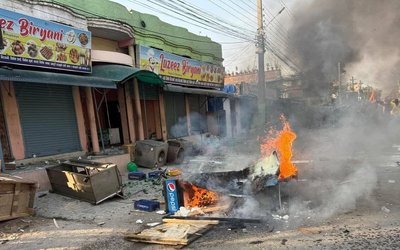More on News





Climate change-driven events like melting glaciers pose a grave risk to Nepal’s economy, and could cause losses equal to almost 10% of the country’s annual gross domestic product (GDP) by 2100, says a new Asian Development Bank (ADB) climate and economics report for South Asia.
“The population is extremely vulnerable, not only to the immediate threats of increasingly frequent glacial lake overflows, landslides, flash floods, and droughts, but also to longer-term climate change, which will ultimately reduce water availability and limit crop productivity,” said Bindu Lohani, ADB Vice-President for Knowledge Management and Sustainable Development.
The report, titled Assessing the Costs of Climate Change and Adaptation in South Asia, predicts the six countries—Bangladesh, Bhutan, India, Maldives, Nepal, and Sri Lanka—will see an average economic loss of 1.8% of their collective GDP every year by 2050, rising sharply to 8.8% in 2100.
Without changes to current global behavior, Nepal would see economic losses equivalent to up to 2.2% of annual GDP by 2050, widening to 9.9% by the end of the century. But if mitigation and adaptation steps are taken, the damage could be limited to around 2.4% of GDP by 2100.
Nepal’s agriculture sector, which employs two thirds of the labor force, will reap some short-term gains from warmer temperatures and melting snow and ice, which boosts water supplies. But over time, glacial retreat and uncertainty about the summer monsoon’s start and end dates will reduce crop yields and cause food insecurity. Melting glaciers, which form high-altitude lakes that can suddenly breach and cause catastrophic flooding downstream, also pose a risk to both human settlements and hydropower systems. In mountainous areas, landslides are likely to increase, threatening lives and infrastructure.
According to a press release Deteriorating and dwindling forests will result in habitat losses for some of the country’s rich flora and fauna, including snow leopards, undermining the country’s appeal for ecotourists.
The cost of climate change adaptation measures in South Asia will depend largely on how the global community tackles the issue, the report says, noting that if the world continues on its path, the region will need to spend at least $73 billion, or an average of 0.86% of its GDP, every year between now and 2100 to adapt to the negative impacts. On the other hand, if countries act together to keep the rise in global temperatures below 2.5°C, the cost of South Asia shielding itself from the worst of the impacts would be nearly halved to around $40.6 billion, or 0.48% of GDP.
The report does not provide detailed adaptation cost projections on a country basis, although in the energy sector it notes that a rising gap between demand and supply could see Nepal face an annual adaptation bill of over $118 million in the 2030s, rising by another $100 million in the 2050s.
The report also details adaptive measures that countries should consider in responding to climate threats, including the use of drought-, flood- and saline-resistant crop varieties, more integrated coastal zone management, increased efficiencies in the energy sector, improved disease and vector surveillance, more protection of groundwater resources and greater use of recycled water.
ADB, based in Manila, is dedicated to reducing poverty in Asia and the Pacific through inclusive economic growth, environmentally sustainable growth, and regional integration. Established in 1966, it is owned by 67 members—48 from the region. In 2013, ADB assistance totaled $21.0 billion, including cofinancing of $6.6 billion.





